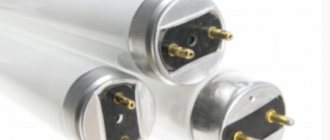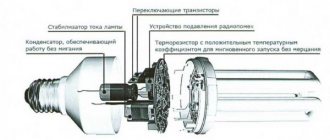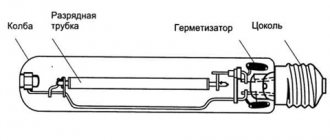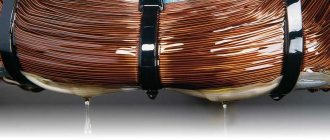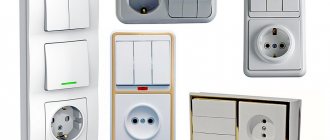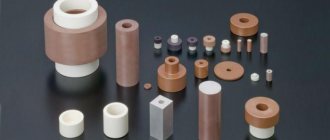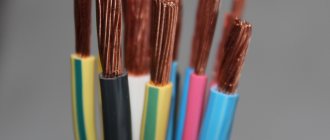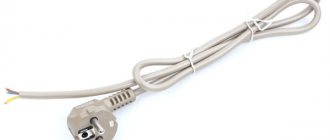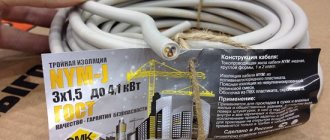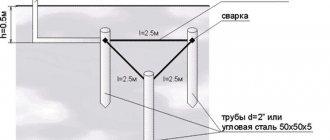Xenon lamp device.
Design of a xenon lamp.
A xenon arc lamp (XAL) produces light due to the appearance of an electric arc in a bulb in a xenon atmosphere. The design is quite simple: a glass bulb, electrodes and a housing in which everything is fixed.
The flask is made of quartz glass. Only such glass can withstand high pressure (up to 30 atmospheres when not in use and 120 atmospheres when lit) and temperature that are necessary for the lamp to operate. Some flasks for special purposes are made from sapphire. It expands the spectral range of emitted light and increases the service life of the CDL.
Depending on the purpose, the flask has different shapes: tube, U-shaped, spiral, ball.
The electrodes are made of refractory tungsten, which is doped with thorium. The addition of thorium increases the lamp burnout speed. To reduce the difference in the coefficients of thermal expansion of tungsten and glass, a special buffer alloy is used: invar (a mixture of nickel and iron). On one side it is fused into the flask, and on the other, electrodes are welded into it. Also, tungsten electrodes are connected to a capacitor in the lamp body. The capacitor has a high voltage charge, reaching up to 2000 V.
A third ignition electrode is built into some CDL models. It is designed to initially ionize xenon and start the lamp discharge.
During operation, the anode gets very hot, so for powerful CDLs the design provides cooling. Light sources with a power of up to 4 kW are cooled with air, and above - with air and water.
Which is better to choose xenon for headlights
For long-distance lighting, the most optimal xenon lamps are from Philips, which have a white color (5000K) and a high level of brightness and luminous flux range. But in this case, automatic switching of the headlights is required so that they do not blind the eyes of the oncoming driver.
Gas lamps of a cool white color, with a slight blue tint (6000K), are also optimal for high beams. This option, according to market statistics, is chosen by motorists in 90% of cases when purchasing xenon out of 100%.
Now let's study what shade of lighting is suitable for fog lights, rear lighting optics or low beam headlights.
What needs to be done to legalize xenon is described in the article: how to legalize xenon.
Read about repairing the xenon ignition unit here.
In the fog lights
To equip fog lights, the best solution would be to choose which xenon shines best in wet weather on wet asphalt and at night in fog.
In this case, suitable lamps are those that:
- not suitable for basic color lighting;
- their brightness does not create an air-water “wall” when visually perceiving a light beam;
- have a sufficient range of luminous flux to “break through” the humidity in the air.
Yellow and green xenon are most often used in such headlights. But for these color lamps, it is best to set the optimal options for high beam to 4300-6000K.
Then, when paired, the lighting will be most familiar to the driver’s eye, and optical discomfort will not be created on a long trip.
In reverse
For rear lighting lamps, xenon lamps can have a glow temperature starting from 8000K. They have the lowest brightness, the bulbs are dimmer, but they have interesting colors - purple, pink, red, gray-blue.
For rear lighting, dim light is allowed in the dark, but only the lamp must correspond to the power that was installed previously.
A standard kit for one flashlight should include the following elements:
- ignition unit – 2 pcs.;
- gas discharge lamp – 2 pcs.;
- wires for connections;
- clamps and fasteners for proper installation;
- diagram and instructions;
- warranty coupon;
- package.
If you install 35-watt lamps in reverse, they often show overheating, which creates a smell of burnt plastic.
The approximate cost of factory rear lighting kits starts from 2,000 rubles, with an average of 5,000 rubles.
In low beam lenses
For close-up lighting, not only the intensity of the light is very important, but also the safety of the optics system. Lighting fixtures should not overheat when producing their brightness.
For low beam lighting, xenon lamps with a power of 35 W (W) are suitable only if the headlight has a lens. Then the luminous flux will be optimal, and overheating will not be observed.
Given the reflectivity of the lens in the headlights, a 50 W bulb will create a thermal effect inside the headlight cavity, which will lead to unwanted overheating.
Important! The best way to prevent yourself from being deceived and buying a fake is to purchase xenon lamps or entire sets only in branded stores:
- Firstly, they will always let you view the quality certificate for the product.
- Secondly, any store of a well-known brand is responsible for the quality (and compliance with the quality) of its product in order to remain in the market as a leader for as long as possible.
On a motorcycle
Tuning in motorcycle transport as xenon headlights with a temperature of 8000 and above is excluded.
For two-wheeled vehicles, dim lights with a short beam range are dangerous. There is a high probability of colliding with objects at high (or any) speed.
The spectral choice of motorcycle xenon comes down to the following options:
- white-yellow (4300K);
- white crystal (5000K);
- white-blue (6000K);
- light blue (8000K) “Crystal”.
The best options will be those that have ignition units specifically designed for motorcycles. For example, the ballast brand is SVS Slim 12V 35W, which has small dimensions and a high-voltage wire of sufficient length.
The peculiarity of a kit for xenon lighting in a motorcycle or moped is the difficulty of finding the right one.
Not every motorcycle will fit the HID xenon kit, which was provided by the manufacturer for vehicles. In addition, paired lamps are more difficult to install in a single-headlight moped or motorcycle.
You have to look for a specially designed kit for motor vehicles. On average, a kit from the factory for a motorcycle will cost from 2,000 to 2,750 rubles.
Principle of operation.
The luminous area is located near the cathode.
A xenon lamp shines due to the appearance of plasma near the cathode. When electric current passes through xenon, gas ionization occurs. The initial stage of ionization is provided by a powerful electric charge that accumulates in the capacitor. This charge is converted into a high-voltage pulse using a step-up transformer. For ignition, a voltage pulse is required, reaching up to 50 kV for powerful CDLs (usually 20-30 kV). The transformer discharges the capacitor - an electrical pulse passes through the lamp, causing primary ionization of the gas. In lamps with an additional electrode, it takes over the ignition function. To maintain the glow, a much lower voltage is required: 85 V.
Next, the current excites more and more xenon atoms. Electrons move to new orbitals with higher energy. When the electrons return back, the excess energy is released in the form of a photon of light. The lamp begins to shine, and the luminous area looks like a cone near the cathode. When using not pure xenon, but its mixture with mercury vapor, the areas of both electrodes glow.
Quartz glass transmits ultraviolet radiation, so ozone is formed when the light source operates. It is harmful to humans. For CDL to operate indoors, forced ventilation is required.
Don't rush to change
Now xenon lamps can also be purchased in the form of separate kits. But there is no need to rush to replace halogen headlights with them.
First of all, find out whether it is prohibited by law in your country to carry out such a replacement. In European countries, for example, it is generally prohibited to sell xenon kits for car conversions.
In the CIS countries the situation is also different. For example, in Russia it is prohibited to make any technical changes to external lighting devices.
Therefore, if you have a foreign car, and xenon lamps are already provided structurally, which means they are automatically adjusted and washed, then replacement with newer products is possible in this case.
And if you have an old Lada and the brightness of the light is not enough, then it is better to install more powerful halogen lamps. But the main thing here is not to overdo it.
After all, a lamp that is too powerful, for example, 100 watts, tends to get very hot, and this will have a detrimental effect on the plastic parts of the headlights, which can become deformed.
Example, Philips H4 X-treme Power halogen lamp.
Also, not every wiring, especially an old car, can withstand such a load.
Also read what are bi-xenon headlights.
Types of xenon lamps.
Types of bases for xenon light sources.
Depending on the purpose, there are three types of different bases: H, HB and D.
Based on their design, there are spherical, tubular and ceramic light sources.
Ball xenon lamps are small, the bulb is in the shape of a ball. Distinctive features are the small size of the luminous area and high brightness of the light.
The electrodes are located at a minimum distance from each other: 3-6 mm or 0.3-2.5 mm for special-purpose lamps. The power of ball light sources reaches 7 kW.
According to Russian standards, ball lamps are designated as DKsSh (arc xenon ball).
This type of light source is widely used for car headlights.
Ceramic light sources are distinguished by the presence of a ceramic bulb in which holes are made for the passage of ultraviolet radiation. They are used in medicine and pharmaceuticals for disinfection.
Tubular CDLs contain a flask in the form of a tube of different lengths and diameters. The electrodes can be located at a considerable distance from each other. According to Russian standards, they are designated as DKsT (arc xenon tubular). The power of such lamps is in the range of 2 W - 50 kW.
For the correct and safe use of tubular xenon lamps, current limiting devices are required, which are built into the electrical circuit. This type of light source is used for external and internal lighting of large areas and objects.
In addition, there is a division of CDL into the following types:
- long-term use with a short arc (similar to xenon headlight lamps);
- long-term use with a long arc (similar to tubular);
- flash lamps (with an additional third electrode for ignition).
There are also lamps operating on direct and alternating current.
Leaders in production
Leaders in the production of such products are SHO-ME (South Korea), MAXLIGHT (South Korea), Xenotex (China), Philips (Netherlands) and Osram (Germany, headquartered in Munich). But it cannot be said that xenon lamps produced in China or South Korea are of low quality. Yes, their cost is very attractive, but still in terms of quality they are not yet ahead of such companies as Osram and Philips.
I would like to talk in more detail about xenon lamps produced by these companies. Their development began in the early 90s of the last century.
Let's face it, the task was not easy.
Despite the fact that such products (the name is derived from the xenon gas used in them) already existed in the form of lighting lamps in everyday life, applying such technology to cars was not easy.
Specifications.
Color temperature DCL.
- Life time. Quite long: about 3000 hours. The design of the lamp contains no elements that can “burn out”. The service life is limited by the characteristics of the device. With prolonged use, due to high heating, the glass becomes brittle, darkens due to metal deposits on the glass, the electrodes become unusable and melt.
- The power of xenon light sources can reach up to 50 kV.
- High color rendering: over 80%. This light is very comfortable for the eyes and does not distort colors. Therefore, CDLs are widely used in photography and filming.
- Colorful temperature. The light spectrum of a xenon lamp is as close as possible to that of the sun. It appears white to the human eye. The color temperature of the radiation starts from 4000 K. Through the use of certain additives to xenon, other spectral colors are possible: 4300 K and 5000 K. In car headlights, light sources with temperatures of 4300, 5000 and 6000 K are most often used.
Summing up
In 2022, finding xenon lamps will not be a problem - unlike 1992, there are now a myriad of companies producing them. And it is worth recognizing that, despite the hegemony of Philips, even inexpensive Chinese and Russian brands can offer competitive options at a very attractive price. Yes, they will not be as good and are unlikely to last even half as long as the top models, but given the difference in cost, this is acceptable. Therefore, you shouldn’t chase brands - yes, ideally, of course, buy a Philips D1S X-tremeVision gen2 4800K or Osram, MTF and Neolux models. But even inexpensive SVS like the Silver Series D1S 6000K are quite capable and provide good levels of illumination. And safety depends not only on the lamps, but also on the person and compliance with traffic rules, the main thing is to buy original products with a guarantee and complying with international standards.
Where are they used?
Xenon headlight bulbs.
From an economic point of view, the most profitable area of application for CDL is lighting large open spaces. This is the lighting of squares, stadiums, skating rinks, quarries, construction sites, and huge production workshops.
Due to their excellent color rendering, xenon lamps are successfully used in projectors, theater, stage, film lighting, and photographic equipment.
In optical instruments, CDLs are used when a minimum luminous area of the light source is required. This ensures the focusing accuracy of the device. CDLs are also used in climatic chambers when testing various materials for light resistance, radiation heating installations, photo exposure, etc.
In recent decades, xenon lamps have been used in the production of automobile headlights. However, due to the brightness of the light, the installation of an additional system for adjusting the angle of headlights and headlight washers is required by law.
Mercury-xenon and ceramic lamps are used in medicine for physiotherapy, sterilization and ozonation.
How to determine the type of base by name: table for decoding
There is a simple way to identify the type of base. To do this, just determine the type of car lamp and check the table.
| Item name | Marking | Application |
| With protective flange | R | Low and high beams, fog lights, combined type headlights |
| Soffitny | SV | Interior lighting, brake lights, registration plate lighting |
| Pin | VA, VAZ and VAY | Tail lights, turn signals, brake light system |
| Glass | W | Car dashboard lighting, side lights, turn signals. |
Advantages and disadvantages.
pros
- high brightness and luminous efficiency;
- short flare-up period;
- long service life;
- the light spectrum is close to natural;
- high efficiency: bright light with low energy consumption to maintain the glow;
- wide power range;
- work at low temperatures.
Minuses
- high price;
- complexity of connection and the need for ballasts;
- explosion hazard;
- high heat;
- the need for automatic adjustment of headlights for a car.
Tips for choosing xenon
When choosing new lighting for your car, always remember the golden rule: “the stingy pays twice,” so don’t be fooled by low prices, bright packaging and sellers’ advice on which xenon is best to install. First of all, ask about the manufacturer, the detailed technical characteristics of the product, as well as what the warranty period is and whether it is provided at all for this product.
In addition, keep in mind that the price for a truly branded xenon will be significantly higher than for a fake. For example, high-quality Philips products have rightfully earned worldwide popularity, but some unscrupulous manufacturers also take advantage of this, shamelessly counterfeiting devices from this brand. Low cost, poorly made product, poor quality packaging or misspelled words on it are all signs of counterfeit xenon.
Features of operation.
Tubular DCL.
To increase the service life of the CDL, you must follow simple rules.
- Do not allow the light source to be turned on and off frequently.
- After turning off, let cool for 10-15 minutes. If this is not done, the spectrum will acquire red and green shades.
- Use high-quality commissioning equipment.
- Make sure the light source is positioned correctly: electrodes in a vertical position, anode on top.
- Wear a protective plexiglass case when transporting and replacing paws. The protective cover will prevent mechanical damage and grease contamination of the flask from human fingers.
- Touch xenon lamps only with protective gloves. Otherwise, be sure to degrease the glass surface with alcohol.
- If the glass bulb is damaged at the slightest level, discard the lamp.
- The average startup voltage of a xenon lamp is 30,000 V. Be careful not to touch the wires, light source and equipment while the light source is operating, before and after startup.
Which company is more reliable?
When trying to determine which xenon lights better from a particular lamp manufacturer, you need to look not only at the prestige of their brand, but also at their demand on the market for at least a couple of years.
If a brand has established itself as producing high-quality xenon, then it makes sense to buy its product.
Today we have the following best options:
| China | CATZ I, PIAA and PF |
| Korea | MTF, Sho-me |
| Germany | Philips, Osram |
| All other car manufacturers that connect standard xenon lighting devices | |
General recommendations from experts on choosing xenon, focusing on the manufacturer:
- The warranty period for the lamp should not be less than 12 months.
- The service life set by the manufacturer - for lamps should not be less than 4 years.
- Price-quality, which can be found out not only from customer reviews, but also from various car service specialists.
- Compliance of the lamps with what is shown on its packaging - parameters, appearance.
- Compliance with factory quality - the brightness of the lamps is 30% higher than that of homemade options.
- Supply of safety systems - the kit must be equipped with a power controller that is capable of turning off the lamp if it is removed carelessly when it is connected to an electric current.
- For better glow and brightness, the bulbs must be coated with a special optical layer.
- Reflector type - scattering shines brighter, but blinds oncoming drivers.
For those who are interested in finding the best option for xenon kits in terms of price and quality, Matsushita lamps are perfect.
